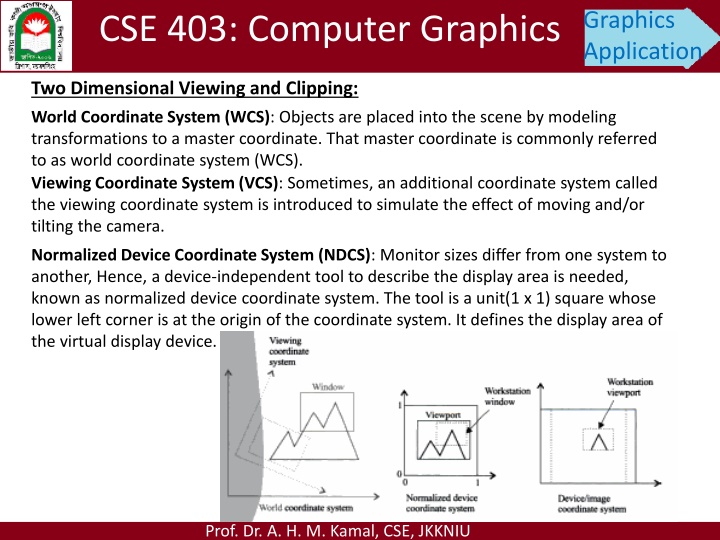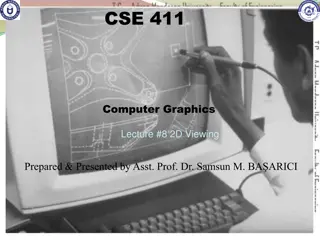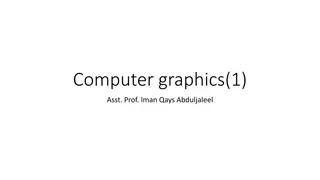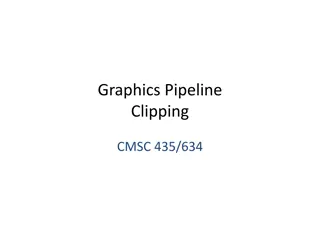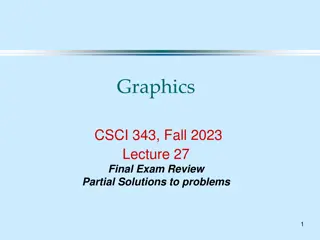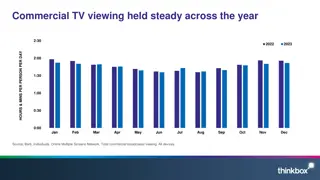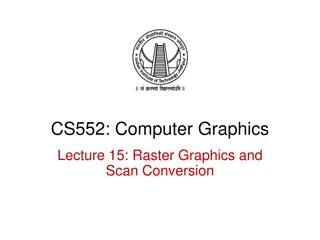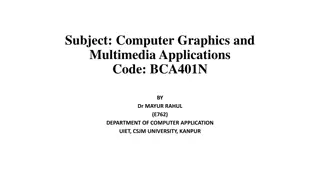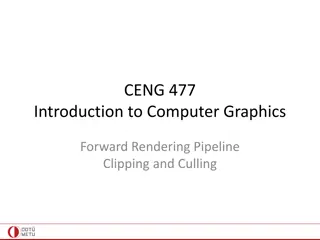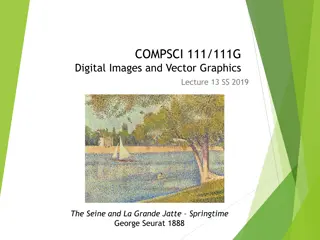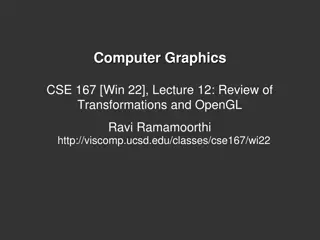Two-Dimensional Viewing and Clipping in Computer Graphics
In computer graphics, objects are positioned in a scene using world and viewing coordinate systems, then clipped for visibility. This involves normalized device coordinates, workstation windows, and window-to-viewport mapping for precise display. Understand the concepts behind these fundamental processes for effective graphics rendering.
Download Presentation

Please find below an Image/Link to download the presentation.
The content on the website is provided AS IS for your information and personal use only. It may not be sold, licensed, or shared on other websites without obtaining consent from the author.If you encounter any issues during the download, it is possible that the publisher has removed the file from their server.
You are allowed to download the files provided on this website for personal or commercial use, subject to the condition that they are used lawfully. All files are the property of their respective owners.
The content on the website is provided AS IS for your information and personal use only. It may not be sold, licensed, or shared on other websites without obtaining consent from the author.
E N D
Presentation Transcript
Graphics Application CSE 403: Computer Graphics Two Dimensional Viewing and Clipping: World Coordinate System (WCS): Objects are placed into the scene by modeling transformations to a master coordinate. That master coordinate is commonly referred to as world coordinate system (WCS). Viewing Coordinate System (VCS): Sometimes, an additional coordinate system called the viewing coordinate system is introduced to simulate the effect of moving and/or tilting the camera. Normalized Device Coordinate System (NDCS): Monitor sizes differ from one system to another, Hence, a device-independent tool to describe the display area is needed, known as normalized device coordinate system. The tool is a unit(1 x 1) square whose lower left corner is at the origin of the coordinate system. It defines the display area of the virtual display device. Prof. Dr. A. H. M. Kamal, CSE, JKKNIU
Graphics Application CSE 403: Computer Graphics Two Dimensional Viewing and Clipping: Normalized Device Coordinate System (NDCS): Monitor sizes differ from one system to another, Hence, a device-independent tool to describe the display area is needed, known as normalized device coordinate system. The tool is a unit(1 x 1) square whose lower left corner is at the origin of the coordinate system. It defines the display area of the virtual display device. Workstation Window: The process that maps normalized device coordinate to discrete device/image coordinate is called workstation transformation. A working window, set in NDCS to do that transformation, is called workstation window. The window works as a workstation window in the NDCS and workstation viewport in the device coordinate system. Workstation transformation depends on the resolution of the display device/ frame buffer. Coordinate mapping from NDCS to device coordinate/image coordinate is called viewing transformation Prof. Dr. A. H. M. Kamal, CSE, JKKNIU
Graphics Application CSE 403: Computer Graphics Two Dimensional Viewing and Clipping: Clipping: A localized view in a scene is performed by setting a window. Since the objects in the scene may be completely inside the window, completely outside the window and partially visible through the window, the clipping operation eliminates objects or portion of objects that are not visible through the window. In world coordinate system, the viewport is called clipping window whereas In viewing coordinate, the workstation window is called clipping window. Prof. Dr. A. H. M. Kamal, CSE, JKKNIU
Graphics Application CSE 403: Computer Graphics Two Dimensional Viewing and Clipping: Window-to-viewport mapping: A window is defined by four world coordinates wxmin, wxmax, wymin, wymax. Similarly a viewport is defined by four world coordinates vxmin, vxmax, vymin, vymax. The objective of window-to-viewport mapping is to convert the world coordinate (wx, wy) of an arbitrary point to its normalized device coordinate (vx, vy). Prof. Dr. A. H. M. Kamal, CSE, JKKNIU
Graphics Application CSE 403: Computer Graphics Two Dimensional Viewing and Clipping: Window-to-viewport mapping: In order to maintain the relative placement we have to maintain the following relationship. and Prof. Dr. A. H. M. Kamal, CSE, JKKNIU
Graphics Application CSE 403: Computer Graphics Two Dimensional Viewing and Clipping: and Where, Prof. Dr. A. H. M. Kamal, CSE, JKKNIU
Graphics Application CSE 403: Computer Graphics Two Dimensional Viewing and Clipping: Prof. Dr. A. H. M. Kamal, CSE, JKKNIU
Graphics Application CSE 403: Computer Graphics Two Dimensional Viewing and Clipping: Line Clipping: The Cohen-Southerland Algorithm The algorithm divides the clipping process into two phases: (1) Identifies those lines which intersect the clipping window and so need to be clipped (2) Perform the clipping First categorizes lines in three groups: 1. Visible both end points of the line inside the clipping window 2. Not visible the line identifies outside the window if two end points (x1,y1) and(x2, y2) satisfies one of the lowing inequalities: 3. Clipping candidate the line is neither in category 1 and 2. Prof. Dr. A. H. M. Kamal, CSE, JKKNIU
Graphics Application CSE 403: Computer Graphics Two Dimensional Viewing and Clipping: Line Clipping: The Cohen-Southerland Algorithm Line Categorizing Algorithm Process in two steps: 1. Assign a 4-bit region code to each end points of each line according to the following figure 2. f The line of category 3 requires to be clipped. Prof. Dr. A. H. M. Kamal, CSE, JKKNIU
Graphics Application CSE 403: Computer Graphics Two Dimensional Viewing and Clipping: Line Clipping: The Cohen-Southerland Algorithm Finding clipping point: Prof. Dr. A. H. M. Kamal, CSE, JKKNIU
Graphics Application CSE 403: Computer Graphics Two Dimensional Viewing and Clipping: Line Clipping: Mid Point Subdivision Algorithm Categorizing lines into three groups: 1. Visible both end points of the line inside the clipping window 2. Not visible the line identifies outside the window if two end points (x1,y1) and(x2, y2) satisfies one of the lowing inequalities: Mid Point Algorithm: 1. Find the mid point of the line. 2. Mid point finding rules are: 3. Xm=(X1+X2)/2 and Ym=(Y1+Y2)/2 4. Determine the clipping categories of these two line segment using region code. 5. Each segment in category 3 is divided further. 6. The process of doing bisection and finding clipping categorization (that is step 1 to 5) is continued until a section s end point falls the boundary of the window. 3. Clipping candidate the line is neither in category 1 and 2. Prof. Dr. A. H. M. Kamal, CSE, JKKNIU
Graphics Application CSE 403: Computer Graphics Two Dimensional Viewing and Clipping: Polygon Clipping: Sutherland-Hodgman Algorithm Let P1, P2, P3, ., Pn are the list of vertices of the polygon and A and B are the end points of any positively oriented edge E of the polygon. Consider an edge E1 {Pi-1Pi}. 1. If both Pi-1 and Pi are to the left of E (see Fig a), vertex P is placed on the output list 2. If Pi-1 and Pi are to the right of E (see Fig b), nothing to do. 3. IfPi-1 is to the left and Pi is to the right of E, (see Fig c), intersection point I of E1 and E are computed and placed on the output list. 4. If Pi-1 is to the right and Pi is to the left of E, (see Fig d), intersection point I of E1 and E are computed and both I and Pi are placed on the output list. Prof. Dr. A. H. M. Kamal, CSE, JKKNIU
Graphics Application CSE 403: Computer Graphics Two Dimensional Viewing and Clipping: Polygon Clipping: Weller-Atherton Algorithm We start with an arbitrary vertex of the subject polygon and trace around its boarder in the clockwise direction until an intersection with the clip polygon is encountered. . If the edge enters the clip polygon, record the intersection point and continue to trace the subject polygon. If the edge leaves the polygon, record the intersection point and make a right turn to follow the clip window . Prof. Dr. A. H. M. Kamal, CSE, JKKNIU
Graphics Application CSE 403: Computer Graphics Two Dimensional Viewing and Clipping: SELF STUDY Solved problem 5.6, 5.7, 5.8 Prof. Dr. A. H. M. Kamal, CSE, JKKNIU
